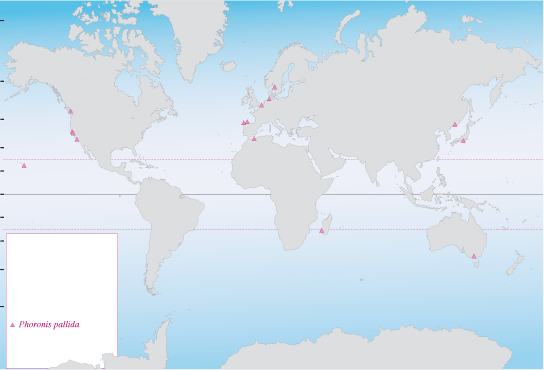|
Phoronis pallida (Schneider, 1862) Silén, 1952. Larva: Actinotrocha pallida Schneider, 1862 |
|
| Synonym:
Phoronis embryolabi Temereva et Chichvarkhin, 2017 |
 ° References of the most recent publications
| ||||||
| Diagnosis | ||||||
|
Last update: June 20, 2017
Extended specimens up to about 140 mm, diameter 0.3 to 1 mm.
Sexual reproduction: hermaphroditic, ova freely discharged in the sea-water; males with large, glandular lophophoral organs.
Phoronis pallida is embedded vertically in soft sediments, generally sand to muddy sand. Santagata (2002) cites a commensalim within the burrow of the thalassinid shrimp Upogebia pugettensis in False Bay (Washington, USA). Temereva & Chichvarkhin (2017) reported two specimens in the burrows of Axiidea shrimp Nihonotrypaea japonica in Vostok Bay (Sea of Japan, Russia)
The distribution of Phoronis pallida is represented below on the map. Last update: June 20, 2017  |

|
Temereva E., 2025. New data on the musculature organization of the atypical phoronid Phoronis embryolabi allow reconstruction of its distinctive lifestyle characteristics. J. Morphol., 286 (9), e70082. Temereva E., 2024. Unusual body division and epithelium structure in unusual phoronid Phoronis embryolabi. Zoology, 167 (126221). References on Phoronis pallida |


